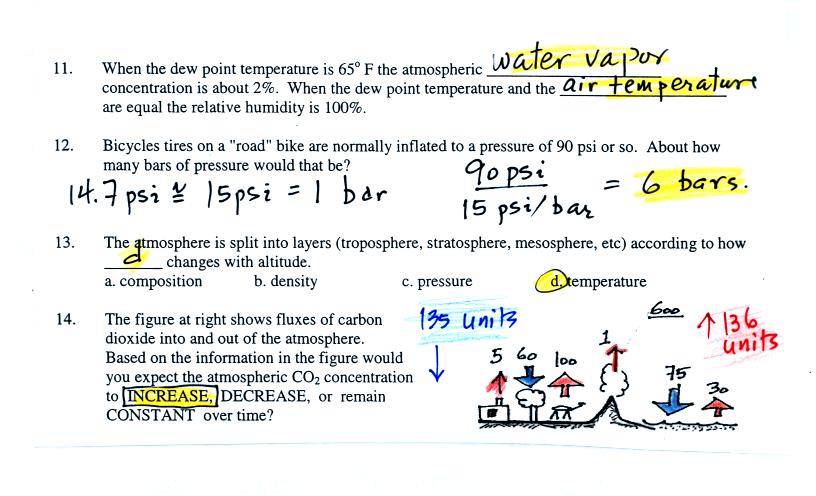Answers to Optional
Assignment #1

Photosynthesis removes CO2 from the air. Just as
atmospheric CO2
concentration peaks during the late winter - early spring when plants
are dead or dormant and photosynthesis is at a minimum, CO2
peaks at
night when photosynthesis activity decreases because there isn't any
sunlight.

The easiest way to answer this question might be to remember that pressure decreases most rapidly
with increasing altitude in dense air. Pressure might
decrease 150 mb in the right column of air when you move from the 900
mb level up to Point B. There would be a smaller decrease in the
lower density air in the right column; pressure might only drop 100
mb. The pressure at Point A is greater than the pressure at Point
B.
When you move downward from the 900 mb level to the ground pressure
will increase. It will increase by 150 mb in the right column and
by 100 mb in the left column. The pressure at Point C is less
than the pressure at Point D.
There is nothing special about the 150 mb and 100 mb values used
above. You could use different values. The important point
is that whatever value you use for the dense air in the right column
must be greater than the value used for the low density air in the left
column.

The figure above shows what would happen during the night when warm air
is in contact with cold ground. At the start of the night the
entire air mass is warm (left figure). By midnight (middle
figure) the bottom layer of air, in contact with the ground will
cool. By the end of the night the layer in contact with the
ground is cold, the middle layer is cool, and the top layer is
warm. Temperature is increasing with increasing altitude, a
temperature inversion has formed during the night.

In Question #9, we really can't see most gases. Pollution
sometimes does produce visible haze, but that is usually because some
of the gaseous constituents of the smog has condensed to form small
particles or drops that scatter sunlight (just like the water droplets
in a cloud or in fog). A similar situation arises in Question #16.
Question #10 is demonstration of an important principle that we will
come back to when we get into Chapter 2. We will find that hot
air floats because it has lower density than the air around it.
Cold air sinks because it has higher density than the air around it.

There is 1 more unit being added to the air in Question #14 than is
being removed. That will cause the atmospheric CO2
concentration
to slowly increase with time.

10% of 1000 mb is 100 mb.
If 1000 mb decreases by 10%, the pressure will drop to (1000 mb -
100 mb) = 900 mb.
10% of 30 inches of mercury (in. Hg) is 3 in. Hg.
So the barometer reading will drop from 30 in. Hg to (30 in. Hg - 3 in.
Hg) = 27 in. Hg.







